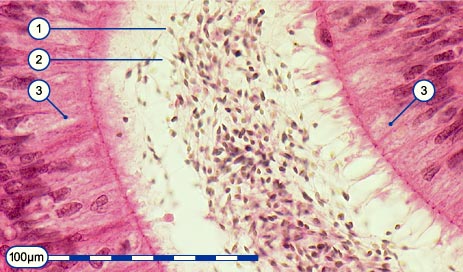|

|
|
|
3.0 Learning aims, what you should already know, introduction, delving deeper
|
|
|
- Origin and migration of the germ cells
- Arrangement of the male gonads
- Arrangement of the female gonads
- Spermatogenesis
- Oogenesis
|
|
|
What you should already know
|
|
|
- General cytology
- Mitosis
- Meiosis
|
|
|
|
Mature germ cells are also termed gametes. There are male gametes, the spermatozoa (sperm cells), and female gametes, the oocytes (egg cells). Through the fusion of the gametes during the fertilization a zygote is created, the first cell of a new individual. In order for it to have the normal number of 46 chromosomes, each of the gametes has half, i.e., 23 chromosomes. The reduction of the number of chromosomes and the recombination of the genetic material are processes, both of which occur during meiosis. Meiosis is a special form of cell division that only takes place in gametogenesis.
|
|
|
| Gametogenesis mainly describes how the oocytes in the ovary and the spermatozoa in the testicles are generated during the period of human sexual maturity. |
|
|
|
|
|
The male gametes are produced in large numbers in the testicles from puberty onwards and for the rest of the man's life. Several million of them are present in a typical ejaculate.
|
|
|
| Fig. 1 - Spermatozooa in the epididymis |
|
Legend |

1
2
3
|
Head of a sperm cell
Tail of a sperm cell
Epithelium of the epididymal duct |
|
|
|
Fig. 1
In this picture a large number of spermatozoa are seen during their passage through the epididymal duct (ductus epididymis)
|
|
The female gametes - oocytes - are already generated and stored during the embryonic and fetal periods and a certain number of them (1 - 2 million) are present in both ovaries when a baby girl is born. The number of the oocytes in the ovaries is thought to constantly diminish right up to menopause. During the fertile period in the life of a woman, from menarche until menopause, roughly 400 oocytes (approximately 13 periods x 30 years) are ovulated. Hormonal regulation, operating in cycles, is responsible for the maturing and expulsion of the oocytes from the follicles.
|
|
|
| Fig. 2 - An oocyte surrounded by follicular cells |
|
Legend |

1
2
3
4
5
6
|
Cytoplasma of the oocyte (ooplasma)
Cell nucleus
Nucleolus
Pellucid zone
Corona radiata cells
Cytoplasmic processes of a corona radiata cell |
|
|
|
Fig. 2
The picture shows an oocyte (diameter ca. 0.1 mm) from a human tertiary follicle.
|
|
Commentary
|
|
In these two images (Figs 1. and 2.), the enormous difference in size between human oocytes and spermatozoa becomes evident: In the oocyte nucleolus numerous sperm cell heads would have room. The oocyte is surrounded by a thick glycoprotein layer (pellucid zone) through which cytoplasmic processes of the corona radiata cells pass, providing conduits for oocyte nourishment to take place.
|
|
|
|
|
The germline:
The development and movement of the (primordial) germ cells proceeding separately from the rest of the somatic cells. |
|
|
|
|
- Why do the gametes have to be haploid?
- How is haploidy achieved?
- When are gametes produced?
- How can the enormous difference in size between female and male gametes be explained?
- Wherein lies the importance of the germline?
|
|
|
Key concepts
|
|
Concepts, that are important in the gametogenesis module.
|
|
|
|
|

